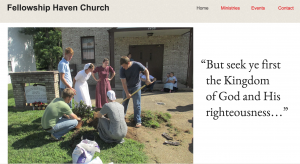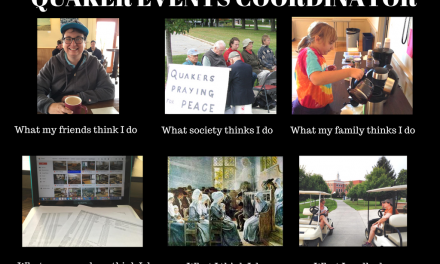Meeting websites are for newcomers. I know most meetings’ websites don’t act like it, but that’s what they should be for.
Story time
A few weeks ago, I was sitting in the meetingroom during introductions after meeting for worship. A couple in their late 20s stood directly behind me and said:
I’m X and this is my partner Y. Like any millennials, we found you online. You have a great website!
(My meeting is Adelphi Friends, if you’d like to take a look at our website.)
I did a little happy-dance 💃🏼 in my seat, as the web developer who built it. I asked them a few questions afterward. Did they find us by search engine or social media? “Google.” With several meetings in this city, why this one?
The first website on the list was really outdated looking. We didn’t know if we could still trust the information, so we moved on. Yours was second.
Websites are for newcomers
Your website is your digital front door. You don’t plaster your meetinghouse’s front door with copies of business meeting minutes, do you? So why make your website merely an archive? And clutter isn’t a good first impression.
Focus
When you recognize websites are for newcomers, the list of pages you should have in your primary navigation menu (which, by the way, should never exceed 7 items) looks more like:
- Home (yes, include it explicitly for people who aren’t so good with computers)
- What we believe/who we are
- Visitors/first-time guests/newcomers/what to expect
- Children/kids
- Give
Show, don’t tell
When you walk down the sidewalk and past restaurants, they always have big glass windows and often windows on the doors. Why? So you can see what it’s like and what the people are like. Is this a casual place, or do the people wear blazers? Is there a light show and DJ or a cellist in the corner?
Your digital front door needs to answer those sorts of questions too! A picture says a thousand words. Show pictures of people as they come to the meetinghouse. I don’t mean “show a group photo of 45 people in front of the building.” I mean take a photo with good lighting (hint: in the shade on a sunny day makes cameras happy) and a few people happily interacting with each other. You want the photos to be close enough that faces and facial expressions are distinctly visible. It shouldn’t be the little dots of people in an impressionist painting.
And please, don’t use stock photos of people. A stock photo of a handshake or a salad is one thing. A stock photo of a face the visitor will never see in your building is deception. Do not be tempted to look younger than you are by using a stock photo of a 25 year old hipster. Do not be tempted to look more racially diverse by using stock photos. Your website needs to reflect reality. Do not pull a bait and switch.
The exception to the “no stock photos of people” rule is children. There are clear reasons to hesitate about putting pictures of your meeting’s children online. Children’s hands raised to answer a question in First day school don’t really present too many fears. Maybe you get a photo of little legs sticking out the end of the slide. A back of a head. But if you’re going to show kids’ faces in anything but a large group photo where nobody’s that recognizable? This is where stock photos come in.
My local Amish church’s website (yes, really!) does a great job of this:
What about everything else?
Yes, you need somewhere to put your meeting minutes and committee assignments and all of that. I hear you. You’re practically shouting.
Put them somewhere out of the way.
That’s it. Some churches have a separate website they don’t really search engine optimize, because it’s just for the regulars to use. Some do this as a subdomain on their site. Some do it as a set of pages on the main site. In any case, a link from a not-prominent part of the homepage (perhaps in the footer) is all you need.
Series
- Websites are for newcomers (this post)
- Web design in 2017
- Suggested WordPress plugins
- Tech to use







Recent Comments